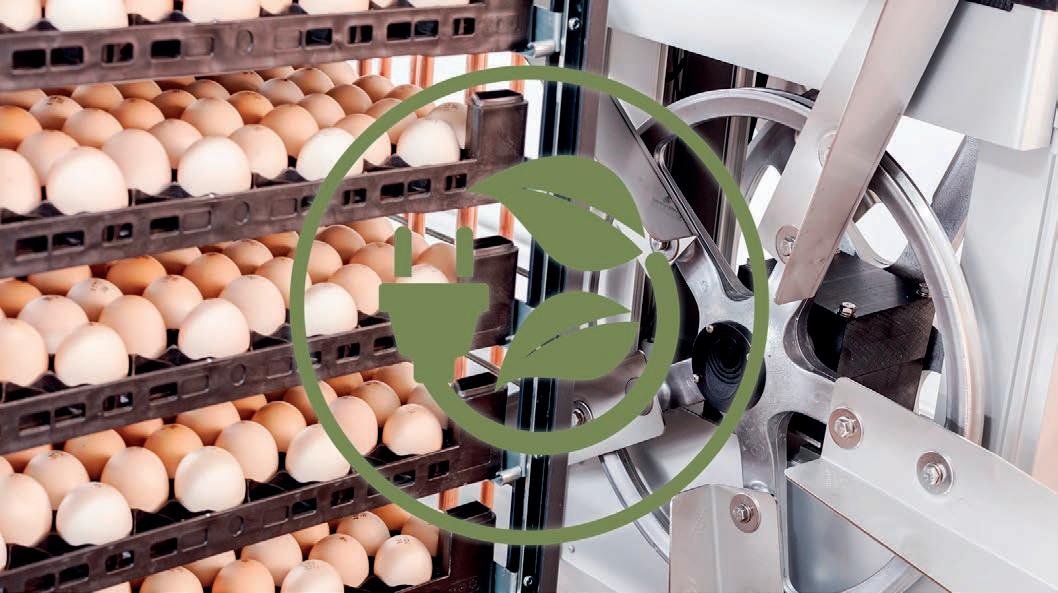
4 minute read
Energy efficiency in the sustainable hatchery
Energy is an important cost factor in the hatchery. Using energy-efficient incubators and HVAC systems can greatly reduce your operational costs. Then again, the benefits are more than just financial: a smaller ecological footprint also creates a more sustainable image for your hatchery. In this article, we consider different ways for hatcheries to achieve the goal of energy conservation and become a more sustainable business.
Incubation with focus on energy conservation
Advertisement
The pulsator fan motor’s electricity consumption takes up a large part of an incubator’s total energy use. When purchasing incubators, it is therefore important to look for equipment that features an energy-efficient pulsator motor. While a high pulsator speed is needed in the beginning and final phase of the incubation process for optimal heating and cooling, the same high speed is not required during the less critical stages of incubation. This is where Petersime’s Eco-Drive™ technology makes the difference, by automatically and safely reducing the pulsator speed during that part of the process.
Thanks to the third power proportion between pulsator speed and pulsator power, reducing the pulsator speed by 20% saves up to 50% of the pulsator’s electricity consumption (see figure on page 31). The benefit of Eco-Drive™ is evident: a positive impact on the incubator’s energy use, and thus on the hatchery’s total energy costs.
Pressure-controlled airflow for maximum energy efficiency
Single-stage incubators have specific air volume demands that vary depending on the stage of the incubation cycle. It is crucial that the supplied air has the correct temperature and humidity to guarantee maximum incubation results. Because outside climate conditions are unstable, a well-designed Heating, Ventilation and Air Conditioning (HVAC) system is required to correctly condition the outside air before bringing it into the incubator rooms and single-stage incubators. As every cubic metre (m³) of conditioned air costs money, selecting the right energy-efficient HVAC system is key.
Certain HVAC systems constantly supply a fixed maximum air volume to the setter and hatcher room. This may seem like a good way to ensure proper climate control when, in fact, a lot of energy is wasted. As the air consumption of single-stage incubators – and incubator rooms – is variable, it is more energy- and cost-efficient to install a pressure-controlled HVAC system that brings in and conditions only the exact amount of air needed at a particular moment in time. Whenever there is an increase or decrease in air consumption, the pressure will respectively drop or rise. A pressure sensor records these fluctuations and adjusts the ventilator speed and airflow. The benefits are significant:
• The ventilator’s electricity consumption is minimised.
• The optimal air volume is being heated, cooled, humidified or dehumidified. In other words, no conditioned air is wasted. This significantly reduces the boiler’s and chiller’s energy consumption.
Pressure control can be applied for all rooms in the hatchery and deliver substantial energy savings, provided that doors are kept closed as much as possible to minimise the loss of conditioned air.
Sustainability through heat recovery in the hatchery
Developing embryos generate high levels of natural heat during incubation. Incubated eggs are constantly exchanging this heat with the surrounding micro-environment inside the incubators. In a standard hatchery, the natural embryonic heat is transferred to the incubator’s cooling water before the chiller disposes the heat to the outside air. This process requires a high electricity consumption, mainly by the chiller. But there is another way: recovering this natural embryonic heat presents a major opportunity to save energy.
In a sustainable hatchery, heat recovery systems recycle the high levels of natural heat generated by the developing embryos inside the incubators. The two main systems are: heat recovery on incubator cooling water and on setter plenum air.
In the first system, the heat from the incubator cooling water is either used to preheat the fresh incoming air in colder climates or to postheat the air after dehumidification in hot and humid climates. This brings a double benefit, enabling a quick return on investment:
• The hatchery’s heating costs go down.
• The chiller’s energy consumption is substantially lower.
As the natural embryonic heat is not only transferred to the incubator cooling water, but also to the surrounding air, the air from the setter plenum can also be used to heat the fresh incoming air. Since the air taken from the setter plenum is considered ‘dirty’, a heat exchanger will be needed to safely transfer heat from one airflow to the other and avoid contamination risks.
Finally, for hatcheries in hot and humid climates, heat recovery on the chiller is another option. The heat from the condensing side of a water-cooled chiller is used to postheat the air after dehumidification. Yet, there are some things to consider to make this successful. Firstly, the overall heating requirements of the hatchery should be lower than the total cooling capacity of the incubators to have a continuously operating system. Secondly, a dry cooler for the water-cooled chiller and a second air-cooled chiller for the HVAC system will be needed.
Conclusion: grab the energy savings potential
As energy prices continue to rise and sustainability grows in importance, it is crucial that every system in your hatchery operates as efficiently as possible.
Although pressure control and heat recovery systems require an initial higher investment, they can offer you a quick return on your investment with energy savings that are economically interesting, plus they help build a sustainable image for your business.










